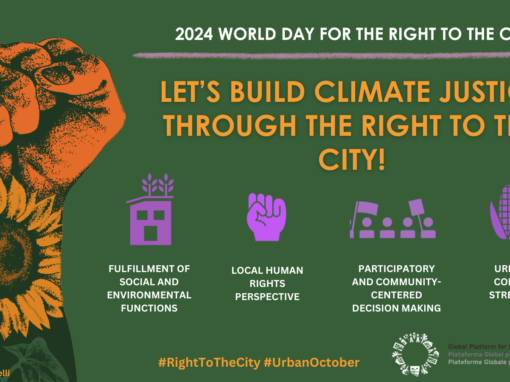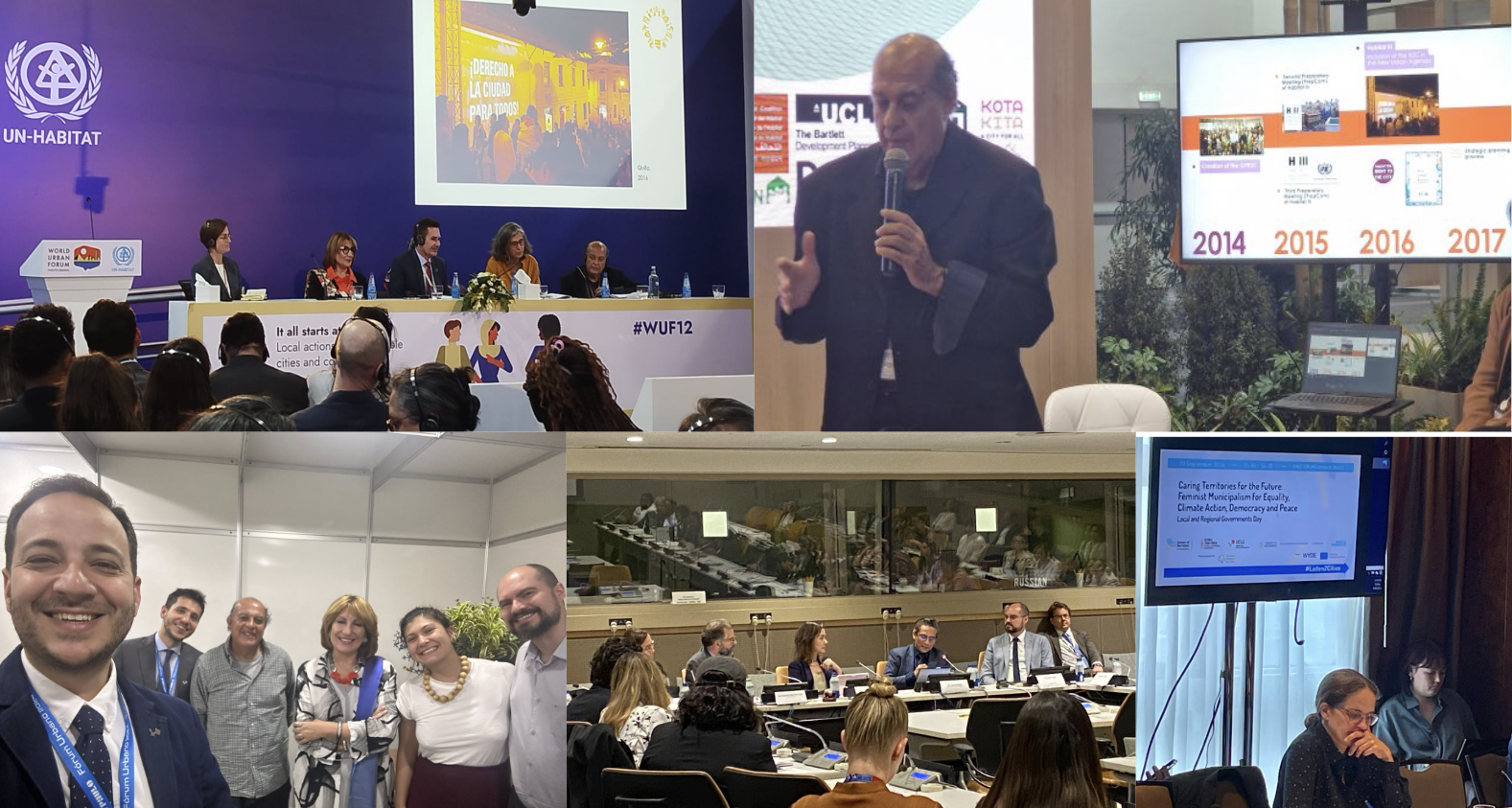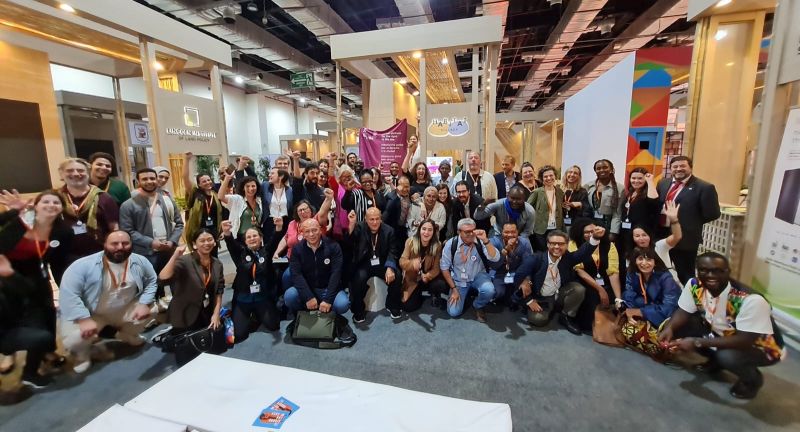Habitat III is a crucial moment to reformulate the life in human settlements. In that context, the Right to the City is a critical tool to ensure that all inhabitants have a place where to live with dignity, in sustainable, democratic and just territories.
What is the Platform for the Right to the City? Why does it come up now?
Participants of the International Meeting on the Right to the City, in Sao Paulo, November 2014, where the Global Platform for the Right to the City was officially launched.
The main elements of the Right to the City paradigm have been part of the debates, proposals and concrete experiences of social movements, civil society organizations, academic institutions and human rights activists in different countries for the last 50 years. In fact, the Right to the City was defended by the social and civil organizations in the Habitat II process and although it was widely mentioned in the preparatory events and documents of the social organizations, it was not explicitly included in the Habitat Agenda, since it is still not recognized by the United Nations. Despite that fact, we shouldn’t forget that some of its elements are included, as the democratic management of the city, the implementation of the human right to adequate housing and the interdependence of urban and rural development.
Based on such background, and taking into account the social processes and instruments developed since the first World Urban Forum, the Global Platform for the Right to the City has been created to advance debates on the definition, content, legal recognition, and implementation of the Right to the City; to promote fair, democratic and sustainable cities and; to make visible and coordinate the urban struggles, as well as strengthen the capacity of civil society organizations. The Platform is an inclusive open forum for the different stakeholders that work on this issue, including, among others, ActionAid, the Brazilian National Urban Reform Forum(Brazil), Cities Alliance, el Consejo y la Facultad Latinoamericana de Ciencias Sociales (CLACSO-FLACSO), Fundación Avina, Global Fund for the Development of Cities (FMDV), Habitat International Coalition (HIC), Habitat for Humanity, International Alliance of Inhabitants (IAI), Polis Institute, Shack/Slum Dwellers International (SDI), StreetNet International, UCLG Committee on Social Inclusion, Participatory Democracy and Human Rights, Women in Informal Employment: Globalizing and Organizing (WIEGO), Women and Habitat Latina American Network (Red Mujer y Habitat), the Huairou Commission, RIPESS (Intercontinental Network for the Promotion of Social Solidarity Economy) and Women in Cities International (WICI).
As stated by Mr Nelson Saule Junior from the Instituto Polis in Brazil-one of the promoting organizations of the Platform- “the building of a Global Platform for the Right to the City is nowadays of paramount importance, in order to strengthen the local and national social struggles, and promote the international mobilization and articulation to influence, among others, the debate for defining the Sustainable Development Goals (Agenda 2030) and the 3rdConference on Housing and Sustainable Urban Development (Habitat III)”.
What can this Platform bring to the Habitat III process?
Habitat III is a UN General Assembly initiative, designed to convene global actors to discuss and chart new pathways toward meeting the challenges of ensuring equitable, sustainable and environmentally sound human settlements, with equal opportunities, democracy and social justice.
It will be in Habitat III where the new commitments will be agreed under the form of a “New Urban Agenda” that will replace the current Habitat Agenda, in order to address the present and future challenges of urbanization and life in the cities. In that sense, it is crucial to recognize the achievements and innovations of civil society and local authorities based upon the Right to the City and the human rights for all.
As affirmed by Mrs Lorena Zárate, Habitat International Coalition‘s current President, “We believe that the civil society and the social movements have a fundamental role to play. On the one hand, to recall the commitments undertaken by the governments and the various stakeholders that were involved in the previous conferences (Habitat I in Vancouver, 1976 and Habitat II in Istanbul, 1996), to evaluate the advances and denounce the setbacks. On the other hand, to make our voices heard and to visibilize our experiences and proposals, in the framework of the debates and the official documents, from the national to the international level. To the present, very few National Habitat Committees have been formed and the national reports, when they exist, have been elaborated with minimal or none involvement of the local communities and organizations.”
What are the Platform expectations regarding the Habitat III process and contents?
The Platform Members stare at this process with major concerns and high expectations.
At the top of that list is the lack of evaluation of Habitat III’s agenda implementation, including the fulfillment of HII’s commitments, since the situation in the human settlements has dramatically deteriorated over the last two decades, in spite of the promises made. They are also concerned about the apparent reduction of the Habitat Agenda to a solely urban focus that leaves out the continuity and symbiosis between the rural and the urban. They are worried about the abandonment of the human rights approach and the fact that, in the preparatory thematic documents, so far, the Right to the City is barely mentioned, despite the fact that the title of one of the Policy Units suggests that this concept must be a core part of them. Finally, they are concerned with the lack of civil society’s participation, as it seems HIII is ignoring that people must be at the center of any habitat policy and social organizations should be consider as a key actor for the definition and implementation of the new agenda.
The Members of the Platform strongly believe that the process of developing a New Urban Agenda must follow a human rights approach with the Right to the City as its cornerstone. They also expect that measures are taken to overcome inequalities, discrimination, segregation and the lack of opportunities so as to ensure livable habitat conditions, both in urban and rural areas. They also propose to implement and enforce existing instruments for participatory planning and budgeting, institutional support for the social production and management of habitat, the democratization of land management, as well as the recognition and respect of the social function of property, land and the city. All these elements are explained and developed in the framework of the Right to the City.
The World Charter for the Right to the City defines this right “as the equitable usufruct of cities within the principles of sustainability, democracy, equity, and social justice. It is the collective right of the inhabitants of cities, in particular of the vulnerable and marginalized groups, that confers upon them legitimacy of action and organization, based on their uses and customs, with the objective to achieve full exercise of the right to free self-determination and an adequate standard of living.” It is a right that confers legitimacy upon people’s action and organization, based on their uses and customs, with the objective to achieve full exercise of the right to an adequate standard of living. Like all human rights, the Right to the City is interdependent of all internationally recognized and integrally conceived human rights. That is why it has interface with civil, political, economic, social, cultural and environmental rights, bringing the dimensions of the territory and the urban life.
In this regard, we – social movements, non-governmental organizations, networks and forums, academic institutions, public sector, foundations and international organizations- Members of the Global Platform for the Right to the City, call for the inclusion of the Right to the City in the New Urban Agenda that will emerge from the Third United Nations Conference on Housing and Sustainable Urban Development (Habitat III) as a transformative way of urban development for just, democratic and sustainable cities.
|
The Platform is internally organized in four Working Groups: Advocacy; Research, Training and Capacity building; Communication and Culture; and Networking and Alliances. The implementation of the Right to the City demands actions in four Thematic Axes, in which the GPR2C members have a great deal of work for the past several decades: Human Rights; Democratic and Participatory Governance; Urbanization, Sustainable Use of the Territory and Social Inclusion; and Economic Development and Social Inclusion. Next Regional Meetings Africa: Johannesburg, South Africa. November 28, 2015; Asia: Surabaya, Indonesia, 20 December 2015; Europe: first trimester of 2016 (place and date tbd). More information: Guiding Document Global Platform R2C Research Moving Toward The Implementation Of The Right To The City GPR2C Statement on Core Messages for Habitat III in the World Habitat Day 2015 |






